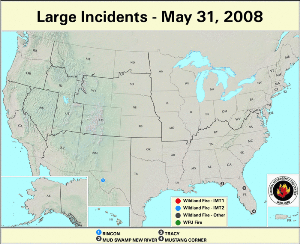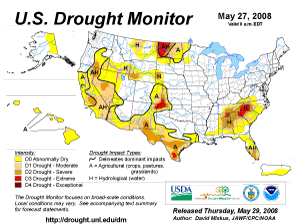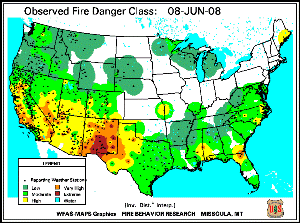At the beginning of May, wildfires continued to burn in the Southwestern U.S., as well as in central California, Florida, and the Southern Appalachians. Several large arson–suspected fires erupted in the middle of the month in Florida and the Southeast. May closed with only three large fires in Florida and one in western Texas. No large fires were reported in Alaska during May.
Long–term moisture deficits have continued to maintain moderate to severe drought conditions across portions of the southern and western United States, including California, Florida, Texas, and the Oklahoma panhandle. Western North Dakota also experienced severe to extreme drought conditions as of the end of May.
As of June 9th, there have been over 28,000 wildland fires and more than 1.5 million acres burned so far this year, according to the National Interagency Fire Center (NIFC). The year 2008 ranks second behind 2006 in quanity of acreage burnt to date, though the number of fires falls well below the 1998–2008 average.
The persistence of moderate–to–severe drought conditions across parts of the West has aided in perpetuating a region of extreme fire potential across parts of the Southwest, according to the U.S. Forest Service (USFS) Experimental Fire Potential Index.
At the end of May, high to very high fire danger was observed across parts of Arizona, New Mexico, southeastern California and west Texas. Adequate precipitation has reduced the fire potential across the southern Atlantic States that had existed in April.
2008 Wildfire Statistics
(Source: NIFC)| Year–To–Date Totals as of June 9th | Nationwide Number of Fires | Nationwide Number of Acres Burned |
|---|---|---|
| 6/09/2008 | 28,690 | 1,562,878 |
| 6/09/2007 | 41,448 | 1,442,932 |
| 6/09/2006 | 44,751 | 2,682,263 |
| 6/09/2005 | 25,835 | 453,472 |
| 6/09/2004 | 33,611 | 574,797 |
| 6/09/2003 | 22,714 | 426,583 |
| 6/09/2002 | 33,247 | 1,313,713 |
| 6/09/2001 | 35,120 | 741,282 |
| 6/09/2000 | 44,169 | 1,200,506 |
| 6–yr average (2003 – 2007) |
34,867 | 1,343,268 |
| 11–yr average (1998 – 2008) |
35,231 | 1,124,934 |
Dead fuel moisture levels remained critically low across portions of the West and Southwest during May. The 10–hour fuel moisture levels also dried out noticeably between April 28th and May 20th over portions of the central and southeastern United States. By June 8th, 10–hour fuel moisture levels were exceptionally dry throughout much of the western U.S., and the eastern U.S. had become substantially drier. Only portions of the Great Lakes and the northern Rockies remained relatively moist.
Medium to larger fuels (i.e., the June 8th 100–hr and June 8th 1000–hr fuel moistures) continued to be dry in the Southwest, while 100–hour moisture levels showed significant drying across the eastern United States since April 28th.
The Keetch–Byram Drought Index (KBDI), a widely used drought index for fire risk, showed a slight improvement in conditions across Nevada, but worsened conditions at the end of May for Texas and Florida, as compared to the April 28 KBDI.
 NOAA's National Centers for Environmental Information
NOAA's National Centers for Environmental Information


